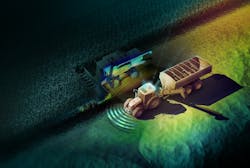Danfoss Forms New Partnerships to Enhance Automation Software
Use of cameras instead of traditional positioning systems provides autonomous vehicles with more accurate vision so they can safely navigate through various types of environments including those with narrow rows of trees, vines or crops. To achieve this capability, Bonsai Robotics' technology utilizes AI (artificial intelligence) and computer vision models to create three-dimensional maps — and thus a more accurate depiction of the environment — for autonomous machines to follow.
READ MORE: Perception Systems Guide the Path to a Fully Autonomous Tractor
"Bonsai’s partnership with Danfoss has allowed us to rapidly integrate with several vehicle form factors in order to add vision-based autonomy and Visionsteer driver augmentation to equipment operating in some of the most challenging conditions," said Tyler Niday, founder and CEO, Bonsai Robotics, in Danfoss' press release. "The beauty of PLUS+1 drive-by-wire systems is that an autonomous perception system can drive the PLUS+1 equipped vehicles through CANbus messages in the same way that a human would use manual controls."
Danfoss is also integrating technology from HARD-LINE, a developer of teleoperation services, into its PLUS+1 Autonomy software. HARD-LINE's technology enables the monitoring and control of machines over the internet and will complement Danfoss' radio-based remote-control technology the company said in its press release.
Teleoperation is well suited for applications in which operators may be remotely controlling and supervising multiple autonomous machines, common in the mining industry where autonomy has been present for several years now.
The HARD-LINE technology enables operators to navigate autonomous machines around obstacles when necessary from a safe distance. If a machine stops due to an unknown obstacle, the operator can log in to the HARD-LINE system, navigate around the obstacle then resume autonomous operation without needing to be close to the machine explains Danfoss. In applications like mining where conditions can be particularly harsh, having the ability to remotely monitor and control machines ensures the safety of operators while also enabling productivity to be maintained as the machine can quickly be put back to work once it is moved away from the obstacle.
"We feel that HARD-LINE’s teleoperation solution is ideal for giving autonomy providers the flexibility to remotely intervene when required during the autonomy process," said Chad Rhude, vice president of U.S. operations, HARD-LINE, in the Danfoss press release. "We look forward to adapting our API to integrate into the PLUS+1 Autonomy platform and working with a great company like Danfoss to bring autonomy and teleoperation to a wider industrial market."
About the Author
Sara Jensen
Executive Editor, Power & Motion
Sara Jensen is executive editor of Power & Motion, directing expanded coverage into the modern fluid power space, as well as mechatronic and smart technologies. She has over 15 years of publishing experience. Prior to Power & Motion she spent 11 years with a trade publication for engineers of heavy-duty equipment, the last 3 of which were as the editor and brand lead. Over the course of her time in the B2B industry, Sara has gained an extensive knowledge of various heavy-duty equipment industries — including construction, agriculture, mining and on-road trucks —along with the systems and market trends which impact them such as fluid power and electronic motion control technologies.
You can follow Sara and Power & Motion via the following social media handles:
X (formerly Twitter): @TechnlgyEditor and @PowerMotionTech
LinkedIn: @SaraJensen and @Power&Motion
Facebook: @PowerMotionTech

Leaders relevant to this article:


